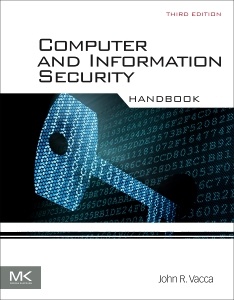Description
Computer and Information Security Handbook (3rd Ed.)
Coordinator: Vacca John
Language: English
Subject for Computer and Information Security Handbook:
1280 p. · 21.5x27.6 cm · Hardback
Description
/li>Contents
/li>Readership
/li>Biography
/li>Comment
/li>
Computer and Information Security Handbook, Third Edition, provides the most current and complete reference on computer security available in one volume. The book offers deep coverage of an extremely wide range of issues in computer and cybersecurity theory, applications, and best practices, offering the latest insights into established and emerging technologies and advancements.
With new parts devoted to such current topics as Cloud Security, Cyber-Physical Security, and Critical Infrastructure Security, the book now has 100 chapters written by leading experts in their fields, as well as 12 updated appendices and an expanded glossary. It continues its successful format of offering problem-solving techniques that use real-life case studies, checklists, hands-on exercises, question and answers, and summaries.
Chapters new to this edition include such timely topics as Cyber Warfare, Endpoint Security, Ethical Hacking, Internet of Things Security, Nanoscale Networking and Communications Security, Social Engineering, System Forensics, Wireless Sensor Network Security, Verifying User and Host Identity, Detecting System Intrusions, Insider Threats, Security Certification and Standards Implementation, Metadata Forensics, Hard Drive Imaging, Context-Aware Multi-Factor Authentication, Cloud Security, Protecting Virtual Infrastructure, Penetration Testing, and much more.
Online chapters can also be found on the book companion website:
https://www.elsevier.com/books-and-journals/book-companion/9780128038437
1. Information Security in the Modern Enterprise 2. Building a Secure Organization 3. A Cryptography Primer 4. Verifying User and Host Identity 5. Detecting System Intrusions 6. Intrusion Detection in Contemporary Environments 7. Preventing System Intrusions 8. Guarding Against Network Intrusions 9. Fault Tolerance and Resilience in Cloud Computing Environments 10. Securing Web Applications, Services and Servers 11. Unix and Linux Security 12. Eliminating the Security Weakness of Linux and Unix Operating Systems 13. Internet Security 14. The Botnet Problem 15. Intranet Security 16. Wireless Network Security 17. Wireless Sensor Network Security 18. Security for the Internet of Things 19. Cellular Network Security 20. RFID Security21. Information Security Essentials for IT Managers, Protecting Mission-Critical Systems 22. Security Management Systems 23. Policy-Driven System Management 24. Social Engineering Deceptions and Defenses 25. Ethical Hacking 26. What Is Vulnerability Assessment? 27. Security Education, Training, and Awareness 28. Risk Management 29. Insider Threats30. Disaster Recovery 31. Disaster Recovery Plans for Small and Medium Business (SMB)32. Security Certification And Standards Implementation 33. Security Policies And Plans Development 34. Cyber Forensics 35. Cyber Forensics and Incident Response 36. Securing eDiscovery 37. Microsoft Office and Metadata Forensics: A Deeper Dive 38. Hard Drive Imaging39. Satellite Encryption 40. Public Key Infrastructure 41. Context-Aware Multi-Factor Authentication 42. Instant-Messaging Security 43. Online Privacy 44. Privacy-enhancing Technologies 45. Detection Of Conflicts In Security Policies 46. Supporting User Privacy Preferences in Digital Interactions 47. Privacy and Security in Environmental Monitoring Systems: Issues and Solutions 48. Virtual Private Networks 49. VoIP Security50. Storage Area Networking Devices Security 51. Securing Cloud Computing Systems 52. Cloud Security 53. Private Cloud Security 54. Virtual Private Cloud Security55. Protecting Virtual Infrastructure 56. SDN and NFV Security57. Physical Security Essentials58. Online Identity and User Management Services 59. Intrusion Prevention and Detection Systems 60. Penetration Testing 61. Access Controls 62. Endpoint Security 63. Fundamentals of Cryptography64. Securing the Infrastructure 65. Cyber Warfare 66. Security Through Diversity 67. Online e-Reputation Management Services 68. Data Loss Protection 69. Satellite Cyber Attack Search and Destroy 70. Advanced Data Encryption Appendices (Online only)
Information Technology and Cyber Security practitioners, researchers, and students, in industry, government, the military, law enforcement, and academia.
- Written by leaders in the field
- Comprehensive and up-to-date coverage of the latest security technologies, issues, and best practices
- Presents methods for analysis, along with problem-solving techniques for implementing practical solutions




